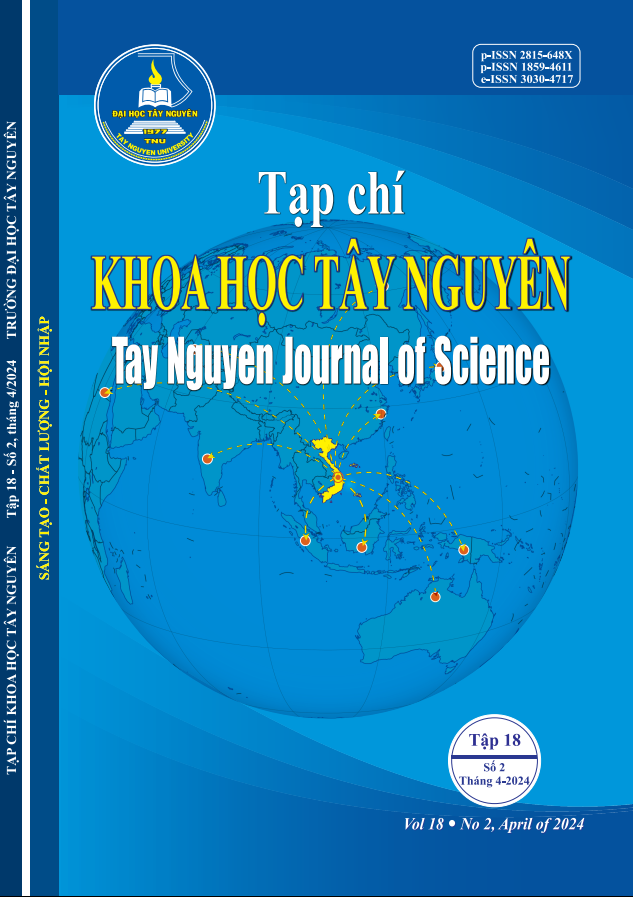Ảnh hưởng của các mức bổ sung Tanin đến khả năng sinh trưởng của dê nuôi thương phẩm
Main Article Content
Ảnh hưởng của các mức bổ sung Tanin đến khả năng sinh trưởng của dê nuôi thương phẩm
Tóm tắt
Nghiên cứu được tiến hành nhằm đánh giá ảnh hưởng của bổ sung tanin đến sinh trưởng của dê nuôi thương phẩm. Thí nghiệm được thiết kế theo mô hình một yếu tố hoàn toàn ngẫu nhiên. 60 dê đực lai F1 (Boer x Bách Thảo) độ tuổi trung bình 4 tháng được phân ngẫu nhiên về 4 nghiệm thức với các mức bổ sung tanin lần lượt là 0, 4, 6, 8 g/kg vật chất khô thức ăn. Kết quả sau 2 tháng nuôi thí nghiệm cho thấy: bổ sung tanin ở mức càng cao càng giảm tỷ lệ tiêu chảy của dê. Tăng khối lượng tích luỹ của dê sau 2 tháng nuôi với các mức bổ sung tanin lần lượt là 8,94; 10,66; 11,20 và 9,88 kg, sự sai khác này có ý nghĩa thống kê P<0,05). Về hiệu quả sử dụng thức ăn cho thấy bổ sung tanin làm giảm đáng kể tiêu tốn thức ăn cho 1 kg tăng khối lượng (P<0,05), trong đó bổ sung ở mức 6g/kg vật chất khô có tiêu tốn thức ăn là thấp nhất đạt 2,48 kgTA/kg tăng khối lượng.
Article Details

Tác phẩm này được cấp phép theo Giấy phép quốc tế Creative Commons Attribution-NonCommercial-NoDeri Phái sinh 4.0 .
Tài liệu tham khảo
- Nguyễn Đức Điện và Lê Văn Khoa (2022). Silvafeed – chiết xuất tannin từ nhiên từ thân cây hạt dẻ giải pháp thay thế kháng sinh trong chăn nuôi. Tạp chí Chăn nuôi số tháng 7. https://nhachannuoi.vn/
- Burke, JM., Miller, JE., Terrill, TH., & Mosjidis, JA. (2014). The effects of supplemental Sericea lespedeza pellets in lambs and kids on growth rate. Livst Sci 159, 29-36.
- Huang, XD., Liang, JB., Tan, HY., Yahya, R., & Ho, YW. (2011). Effects of Leucaena condensed tanins of differing molecular weights on in vitro CH4 production. Anim Feed Sci Tech 166-167, 373-376.
- Johnson, D. E., & Ward, G. M. (1996). Estimates of animal mêtane emissions. Environmental Monitoring and Assessment. Vol 42 (1-2). pp. 133–41.
- Linus Pauling Institute (2023). Micronutrient Information Center. Flavonoids. https://lpi.oregonstate.edu/mic/dietary -factors/phytochemicals/flavonoids.
- Liu, XL., Hao, YQ., Jin, L., Xu, ZJ., McAllister, TA., & Wang, Y. (2013). Anti-Escherichia coli O157: H7 properties of purple prairie clover and sainfoin condensed tannins. Molecules; 18:2183-99.
- Manach, C., Williamson, G., Morand, C., Scalbert, A., & Rémésy, C. (2005). Bioavailability and bioefficacy of polyphenols in humans. I. Review of 97 bioavailability studies. American Journal of Clinical Nutrition. 81, 230S–242S.
- Rezar, V., & Salobir, J., (2014). Effects of tannin-rich sweet chestnut (Castanea sativa mill.) wood extract supplementation on nutrient utilisation and excreta dry matter content in broiler chickens. Poult.Science,78.
- Scalbert, A. (1991). Antimicrobial properties of tannins. Phytochemistry; 30:3875 – 83
- Smith, AH., & Mackie, RI. (2004). Effect of condensed tannins on bacterial diversity and metabolic activity in the rat gastrointestinal tract. Appl Environ Microbiol; 70:1104 – 15
- Strick, R., Strissel, PL., Borgers, S., Smith, SL., & Rowley, JD. (2000). Dietary bioflavonoids induce cleavage in the MLL gene and may contribute to infant leukemia. Proc Natl Acad Sci U S A. 97 (9): 4790–5.
- Puchala, R., Animut, G., Patra, AK., Detweiler, GD., Wells, JE., Varel, VH., Sahlu, T., & Goetsch, AL. (2012). Effects of different fresh-cut forages and their hays on feed intake, digestibility, heat production, and ruminal methane emission by Boer × Spanish goats. J Anim Sci 90, 2754-2762.
- Waghorn, GC., Ulyatt, MJ., John, A., & Fisher, MT. (1987). The effect of condensed tanins on the site of digestion of amino acids and others nutrients in sheep fed on Lotus corniculatus L. Br. J. Nutri. 57: 115-126.
- Waghorn, GC. (1990). Beneficial effects of low concentration of condensed tanins in forages fed to ruminants. In: D.E. Akin, L.G. Ljungdahl, J.R. Wilson and P.J. Harris (eds). Microbial and plant opportunities to improve lignocellulose utilisation by ruminants. Elsevier Sciences Publishing Co., New York. PP. 137-147.



